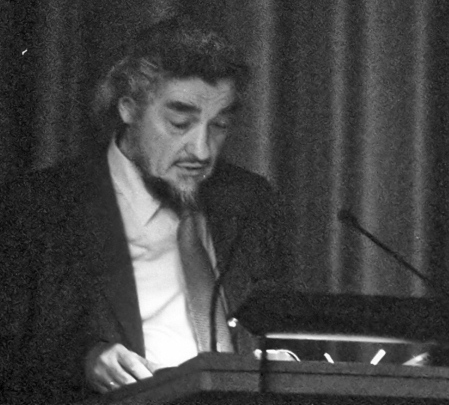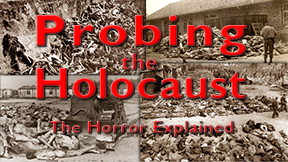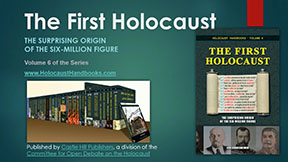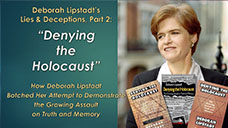
Prof. Dr. Wolfgang Eßbach
During the fall semester 2009/2010, Prof. Dr. Wolfgang Eßbach, sociologist at the University of Freiburg, Germany, lectured about “Culture theory in Germany and France since 1968.”[1] One focus of his lecture was on the topic of “Ethical Problematizations after the Modernization Catastrophes of the 20th Century.” In it Prof. Eßbach treated three modernization catastrophes: the Soviet GULag, the Holocaust as well as “Hiroshima,” that is, the nuclear US-Americans’ bombardments of the Japanese cities Hiroshima and Nagasaki.
As a Holocaust revisionist I limit myself to an analysis of the parts in which Prof. Eßbach deals with “Auschwitz.” Interestingly, a disruption in continuity regarding the Holocaust exists according to Eßbach, because the nowadays otherwise enlightened and rational West refuses to approach this topic in a critical, rational, enlightened way, and that those who claim to do this anyway – the revisionists, who he even calls that way – justly face societal ostracism, moral rejection and prosecution.[2] He also considers it justified that the topic has been “sacralized,” has turned (not only) in Germany into a kind of “civil religion,” und that students are brainwashed in school in that sense (10: 36:27-37:36). In my book Resistance is Obligatory I have written in detail what I think about that, hence I will not elaborate on this any further here. Below I want to discuss a few factual statements made by Prof. Dr. Eßbach which will prove his basic hypothesis about the legitimacy of refusing a discourse to be untenable.
Wannsee
In his lectures Prof. Eßbach makes only three statements about what revisionists allegedly claim, and all three of them are either wrong or they are subsequently grotesquely distorted.
The first statement concerns the so-called Wannsee Protocol of January 1942. This document is said to summarize the contents of a meeting which was held among second-tier politicians of the Third Reich regarding the implementation of plans about the so-called “Final Solution of the Jewish Question.”
Prof. Eßbach claims that the fact that we do not have an exact transcript of the Wannsee conference, revisionists claim that this has to lead to doubts whether that conference took place in the first place (11: 12:49-13:00). I am not aware of any revisionist text that claims this. Regarding the Wannsee Protocol, the revisionists are basically divided into two groups:
a) One group insists that the two version of the Wannsee Protocol known today are forgeries. The reasons for this are manifold and will not be repeated here. None of the authors adhering to this thesis has ever claimed, however, that such a conference never took place. Quite to the contrary, their critique even dealt to various degrees with what the participants of this conference have claimed about it later on. When it comes to this document’s contents, this group is merely concerned with whether that which is written in the protocol conforms to what was discussed during that meeting.[3]
b) A second group assumes at least that the protocol’s contents are authentic, and maybe that it itself is genuine, because it does not contain anything that hints at a physical extermination of the Jews. The contents of that document are therefore in basic agreement with what this group considers to be historical facts.[4]
I will not deal here with Prof. Eßbach’s brief attempt to contradict this revisionist mirage, as the underlying claim is simply wrong. In this context it matters only that Prof. Eßbach uses this example to emphasize that “Auschwitz” resulted in a disruption of the continuity of the project of enlightenment, to a disruption of the continuity of the communicative community which refuses to take seriously iconoclastic theses about the Holocaust, let along to discuss them, which is in stark contrast to the Western enlightened ideal, according to which doubting and critical questioning are laudable activities. At the end, Prof. Eßbach negates the question of whether one should get involved in a discourse with Holocaust doubters, whether it is ethically justifiable to enter into a revisionist discourse. For ethical reasons, he opines, the horrors of Auschwitz delegitimize any room for rational doubt.
Victim Numbers
According to Prof. Eßbach, the revisionists opine that much less people were murdered in the gas chambers at Auschwitz-Birkenau than claimed so far (11: 18:45-50). On this issue Prof. Eßbach rigs an alleged ethical dilemma, namely the dilemma between the wanting-to-know or having-to-want-to-know in the tradition of the enlightenment on the one hand and the alleged ethical dismay on the other hand when confronted with somebody who, in the face of this unfathomable mass murder, is counting beans, if I may use this colloquial expression here. But this is only an apparent dilemma. First of all science has always the right to determine numbers thoroughly and as accurately as possible. If it were any different, we would leave the terrain of science, also of historiography, which Prof. Eßbach explains as well (11: 19:10-25). Even the exterminationists themselves have at times compiled detailed victim tallies,[5] and during the remainder of his lecture hour, Prof. Eßbach introduces a few of them in order to show that number controversies about Auschwitz are quite “normal” and will probably remain so in the future.
Fact is that nobody complains about the number research by orthodox historians. Some people’s heckles go up only if the “wrong” people arrive at the “wrong” results, namely to such results which are considerably lower than those which at that particular time are considered to be true. Hardly anybody is enraged by inflated victim numbers – like those mentioned by Eßbach himself: the 8 million claimed by the French or the 4 million claimed by the Stalinist Soviets and Poles right after the war. To Prof. Eßbach such numbers don’t seem to pose an ethical problem. True should be, though, that any wrong number is ethically questionable, that it is therefore ethically imperative to determine the correct number – which can done only by science, though, not by penal law, sacralization, tabooization, brain washing or any other approach of “social engineering.”
In addition, revisionists do not claim that much less people were murdered in the gas chambers at Auschwitz as officially claimed, but rather that there were NO GAS CHAMBERS at Auschwitz, that therefore NOBODY was murdered with gas. If that is correct, then we are talking no longer about the petty counting of beans but about the possible crime against people, or against entire groups of people, who are wrongly accused of a gigantic crime. Any refusal to discuss this, which prevents that the accused can defend and potentially exonerate himself, is just as ethically reprehensible as it would be to deny the alleged victims, or groups of victims, a discourse about their fate. Ethics apply to both sides. Prof. Eßbach has missed that point. He, as so many other Germans, does not seem to see an ethical problem in the fact that his own ethnic group and culture is charged with almost any imaginable historical horror story. That is perfectly alright. After all, it only hits the right guys, if it hits the Germans, right? Because Germans only feel really comfy if they are allowed to feel guilty. “And woe to them who tries to take away my guilt complex!” This German flagellantism is worth its own psychiatric assessment, but I will not do that here.
Prof. Eßbach uses the moral horror triggered, among other things, due to numbers (“millions of victims”) in order to stigmatize a discussion about exactly these numbers, among other things. Yet this attempt at immunizing claims from possible criticism is itself a morally reprehensible approach.
Faurisson
Prof. Eßbach quotes Prof. Faurisson with the words that Faurisson has, “though in vain, looked for a single former deportee who could prove to me that he had actually seen a gas chamber with his own eyes.” Prof. Eßbach continues with a quote by Jean-François Lyotard from his book The Differend (Univ. of Minnesota Press, 1989/Manchester University Press, 1988; 12: 4:30-5:06; here retranslated from Eßbach’s lecture quote):
“To actually have seen a gas chamber with ones own eyes would be the prerequisite for the authority to claim their existence and to teach the disbeliever. In addition, one has to prove that it was lethal at the moment one saw it. The only acceptable evidence for their lethal effect would be that one is dead. But a dead person cannot testify that he has died in a gas chamber. […] In order to identify a room as a gas chamber, I accept only a victim of the gas chamber. Yet according to my opponent, there can only be dead victims, or else the gas chamber would not be what he claims it to be. Hence no gas chamber exists. […] Since the witness exists only as a victim, [and] the victim only as a dead person, no room can be identified as a gas chamber.”
Prof. Eßbach claims next, “what Faurisson claims is untenable” and unacceptable (12: 5:33-46). However, only Lyotard’s extrapolation of Faurisson’s statement is actually untenable and unacceptable. Reading Faurisson’s writings would have convinced both that Faurisson has never posited such an absurd definition of an acceptable gas chamber proof. Faurisson would accept both material evidence and documents, but such evidence does not exist. He would also accept credible statements by trustworthy witnesses. There are a great many individuals who claim to have seen a gas chamber with their own eyes without having perished in it. The court files and the literature is full of such statements. Faurisson has interviewed some of these witnesses himself, and in other cases he has perused their statements critically. All these witnesses have reported things which in his eyes are physically impossible, due to which he rejects these statements – and not because these witnesses have survived their claimed encounter with a gas chamber.
Here Prof. Eßbach commits the categorical error of blaming Faurisson for Lyotard’s absurd pseudo-argument.
Lyotard’s subsequent discussion and following this the elaborations by Eßbach are somewhat comical, as they are first of all based on an utterly false premise, and because they take Lyotard’s absurd extrapolation seriously to begin with. But a thesis which for principle reason cannot be verified – like for instance “gas chambers can only be proved by statements of deceased witnesses” – are impermissible from the outset. Hence the French philosopher Lyotard has written an entire book about something that logically seen isn’t even permissible.
I may indicate that the absurd way of arguing imputed to Faurisson is actually the rule for the other site. Simone Veil, first president of the European Parliament and a Jewish Auschwitz survivor, has phrased it as follows in an exemplary way (France-Soir, May 7, 1983, S. 47):
“Everyone knows that the Nazis destroyed these gas chambers and systematically eradicated all the witnesses.”
U.S. mainstream historian Dr. Arno J. Mayer has expressed this somewhat more academically, but basically saying the same thing:[6]
“Sources for the study of the gas chambers are at once rare and unreliable. Even though Hitler and the Nazis made no secret of their war on the Jews, the SS operatives dutifully eliminated all traces of their murderous activities and instruments. No written orders for gassing have turned up thus far. The SS not only destroyed most camp records, which were in any case incomplete, but also razed nearly all killing and crematory installations well before the arrival of Soviet troops. Likewise, care was taken to dispose of the bones and ashes of the victims.”
But theses statements are not only factually wrong – because first of all not everybody knows this, second many witnesses have survived, third some of the buildings claimed to have served as gas chambers exist to this day, and fourth the Soviets have captured the complete files of the Central Construction Office at Auschwitz – but they are also logically inadmissible, because here the alleged lack of evidence is used – not to unsettle a thesis, but to support it.
The thesis of the destruction of evidence runs through the orthodox literature like a red thread. The revisionist literature, on the other hand, deals with evidence that can actually be found, whatever it may prove. Hence the shoe is on the other foot: The exterminationists argue in a way which is a radical disruption of the norms for a rational discourse.
Conclusions
Prof. Eßbach uses the absurd thesis of the French philosopher Lyotard, which is evidently based on a false premise, in order to defend the orthodoxy’s refusal of a discourse with revisionism as allegedly being ethically justified also on the level of academia. He calls this the universities’ contribution to whetting the “weapons of criticism” (10: 37:37-48) – although the exact opposite is true: refusing to acknowledge and to discuss attempts of a critical discourse does not whet the weapons of criticism, but rather relegates them to the armory and relinquishes the topic to the revisionists without a fight.
Notes
| [1] | http://podcasts.uni-freiburg.de/podcast_content?id_content=87 |
| [2] | Ibid., 10th podcast, 34 min. 50 sec. and thereafter. The following numbers and times in parentheses refer to the respective postcast files on the website mentioned above. |
| [3] | Esp.: Hans Wahls, Zur Authentizität des “Wannsee-Protokolls”, Veröffentlichungen der Zeitgeschichtlichen Forschungsstelle Ingolstadt, vol. 10, Ingolstadt 1987; U. Walendy, “Die Wannsee-Konferenz vom 20.1.1942”, Historische Tatsachen No. 35, Verlag für Volkstum und Zeitgeschichtsforschung, Vlotho 1988; R. Bohlinger, J. P. Ney, Gutachten zur Frage der Echtheit des sogenannten Wannsee-Protokolls und der dazugehörigen Schriftstücke, Deutscher Rechts- und Lebensschutz-Verband (ed.), Verlag für ganzheitliche Forschung und Kultur, Viöl 1992; Roland Bohlinger (ed.), Die Stellungnahme der Leitung der Gedenkstätte Haus der Wannsee-Konferenz zu dem von Bohlinger und Ney verfaßten Gutachten zur Frage der Echtheit des sogenannten Wannsee-Protokolls und der dazugehörigen Schriftstücke, Verlag für ganzheitliche Forschung, Viöl 1995 |
| [4] | Jürgen Graf, Thomas Kues, Carlo Mattogno, Sobibór, The Barnes Review, Washington, DC, 2010, p. 205. |
| [5] | Franciszek Piper, Die Zahl der Opfer von Auschwitz, Verlag Staatliches Museum, Auschwitz 1993. |
| [6] | Arno J. Mayer, Why Did the Heavens Not Darken? Pantheon, New York 1990, p. 362. |






